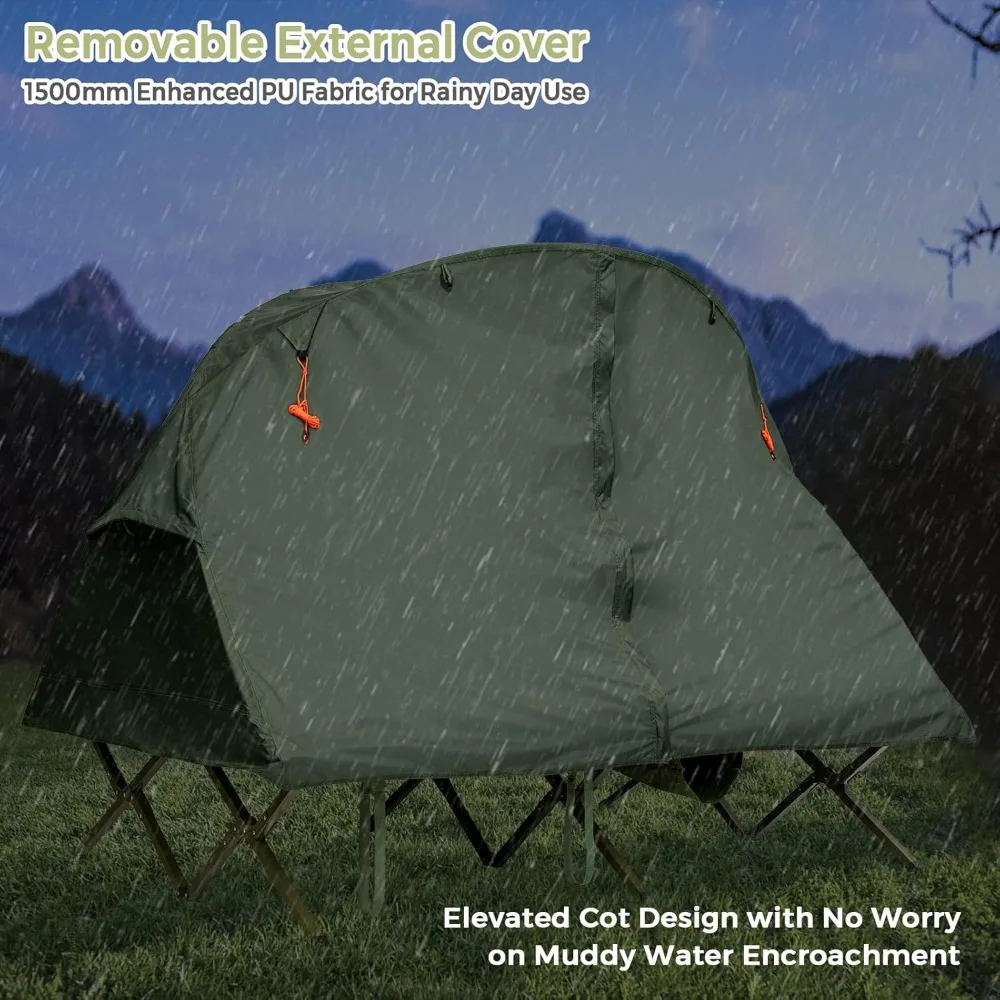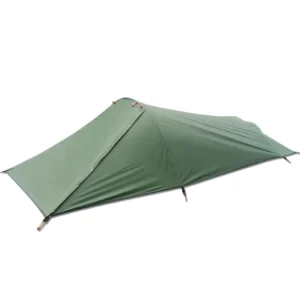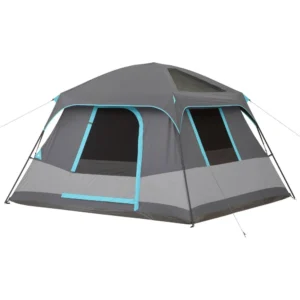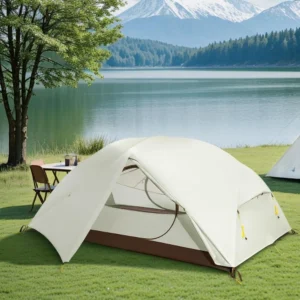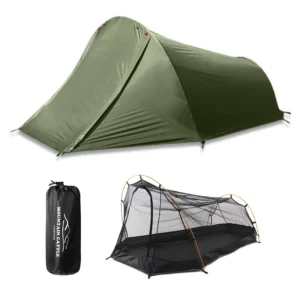Introduction: Finding Your Perfect Two-Person Shelter
When it comes to outdoor adventures, dome tents have become the go-to choice for many campers and hikers. Their distinctive curved shape isn’t just visually appealing—it’s a thoughtful design that offers exceptional benefits for two-person camping trips.
Dome tents stand out because of their:
- Excellent stability in windy conditions due to their aerodynamic shape
- Simple setup with typically just 2-3 crossing poles
- Great headroom in the center while maintaining a compact footprint
- Versatile performance across different environments
Selecting the right two-person dome tent is one of the most important decisions you’ll make when planning your outdoor adventures. Whether you’re backpacking through mountain trails or enjoying a relaxed weekend at a campsite, your tent serves as your home away from home—protecting you from rain, wind, and providing comfort after long days outdoors.
The perfect dome tent balances several crucial factors: weight that won’t burden you on the trail, adequate space for two adults and gear, reliable weather protection for unexpected storms, durability to withstand regular use, and intuitive setup that won’t leave you frustrated as daylight fades.
This guide will help you navigate these considerations to find your ideal tent match, whether you’re prioritizing ultralight backpacking, comfortable weekend camping, or all-weather protection. Understanding the fundamental dome tent structure will help you make more informed decisions as you explore the options.
The advantages of two-person dome tents make them particularly well-suited for couples and adventure partners seeking a balance of space, weight, and protection.
Why Trust Our Recommendations
At Explore Elements, our recommendations come from a combination of hands-on testing and thorough research. Our evaluation process includes:
- Physical testing of tents in diverse environments from alpine meadows to desert terrain
- Analysis of hundreds of verified customer reviews across multiple platforms
- Consultation with outdoor guides and tent design specialists
- Detailed comparison of technical specifications against real-world performance
Our testing involves setting up each tent multiple times under different conditions—from calm, sunny days to windy, rainy evenings. We’ve slept in these tents during unexpected storms, packed them through narrow trails, and evaluated how they hold up after dozens of uses.
We pay special attention to the features that truly matter: how well seams hold up in heavy rain, how easily zippers operate after exposure to sand and dirt, and whether a tent really offers enough space for two adults as advertised.
This comprehensive approach allows us to provide recommendations based on actual performance rather than marketing claims. The dome tent shapes and stability properties we discuss come from real testing and technical analysis, not manufacturer hype.
Quick Picks: Top 2-Person Dome Tents at a Glance
- Best Overall: MSR Hubba Hubba NX 2 – Perfect balance of weight, space, and weather protection with premium materials and thoughtful design
- Best Value: REI Co-op Passage 2 – Remarkable quality and durability at an affordable price point with surprising attention to detail
- Best for Backpacking: Big Agnes Copper Spur HV UL2 – Ultralight construction without sacrificing comfort, featuring impressive interior space for its minimal weight
- Most Durable/Weatherproof: The North Face Mountain 25 – Bombproof construction designed for extreme conditions with reinforced poles and dense fabric
- Easiest Setup: Coleman Sundome 2 – Simple, color-coded design allows for setup in under 10 minutes with minimal frustration
For a complete selection of quality options, browse our carefully curated dome camping tent collection.
Best Overall: The Ultimate Balance of Features
The MSR Hubba Hubba NX 2 represents the perfect synthesis of what most campers need in a two-person dome tent. It strikes an impressive balance between weight, livability, and weather protection that makes it versatile for nearly any adventure.
Key Specifications:
– Weight: 3 lbs 14 oz (1.76 kg) packed weight
– Floor dimensions: 84 x 50 inches (213 x 127 cm)
– Peak height: 40 inches (102 cm)
– Seasons: 3-season
– Doors: 2 doors with vestibules
– Packed size: 18 x 6 inches (46 x 15 cm)
The Hubba Hubba’s standout feature is its livable space. While many “two-person” tents feel cramped, this one provides genuine comfort for two adults. The near-vertical sidewalls maximize the usable interior space, while the symmetrical design means neither camper gets the “bad” spot. With two doors and vestibules, each person has their own entrance and gear storage area, eliminating the need to climb over your partner for midnight bathroom breaks.
Setting up the Hubba Hubba is remarkably intuitive thanks to its unified hub-and-pole system. Most users can have it pitched in under 5 minutes once familiar with the process—a welcome feature when you’re setting up in the rain or fading light.
Weather protection is where this tent truly shines. The full-coverage rainfly extends to the ground while maintaining excellent ventilation, preventing the condensation issues common in many waterproof tents. The 20-denier ripstop nylon fabric strikes an ideal balance between weight and durability, while the DWR coating and precision-seamed design keep water out during sustained downpours.
For campers who want a reliable tent that excels across multiple scenarios, from weekend camping to multi-day backpacking, the Hubba Hubba offers the versatility that justifies its premium price point. Compare this option with other top 2-person tents to see how it stacks up against specialized alternatives.
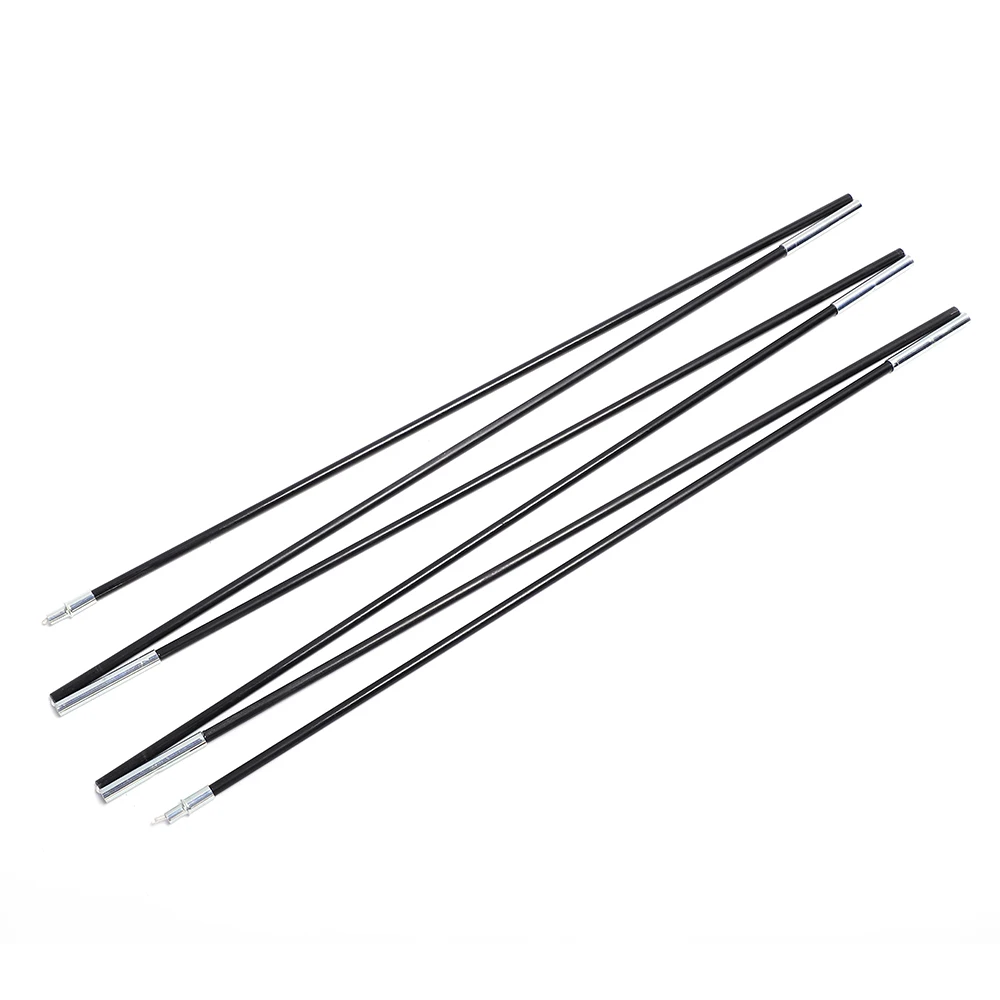
Best Value: Quality on a Budget
The REI Co-op Passage 2 demonstrates that quality outdoor gear doesn’t always require premium pricing. This tent delivers excellent performance at roughly half the cost of our best overall pick, making it an outstanding value proposition.
Key Specifications:
– Weight: 5 lbs 10 oz (2.55 kg) packed weight
– Floor dimensions: 88 x 52 inches (224 x 132 cm)
– Peak height: 40 inches (102 cm)
– Seasons: 3-season
– Doors: 2 doors with vestibules
– Packed size: 18 x 8 inches (46 x 20 cm)
The Passage 2 doesn’t cut corners where it matters. Its 75-denier floor fabric is actually more durable than many higher-priced options, promising excellent longevity with proper care. The aluminum poles provide reliable structure, unlike the fiberglass poles commonly found in budget tents that are prone to splitting or breaking.
Where does it compromise compared to premium models? Primarily in weight and packability. At over 5 pounds, it’s noticeably heavier than ultralight options, making it better suited for car camping or short backpacking trips where weight isn’t the primary concern.
The interior space is genuinely comfortable for two average-sized adults, and the inclusion of two doors—a feature often eliminated in budget tents—significantly enhances livability. The X-pole design creates stable, near-vertical walls that maximize usable space.
Weather protection is impressive, with a full-coverage rainfly and well-designed ventilation to manage condensation. While the waterproofing isn’t quite as robust as premium models, it handles typical rainstorms without issue.
For weekend campers, festival-goers, and occasional backpackers who prioritize durability and comfort over minimum weight, the Passage 2 delivers exceptional value. Its thoughtful design and quality construction offer performance that rivals much more expensive alternatives.
We offer a variety of 2-person camping tents at different price points to fit various budgets and needs.
Best Ultralight: Perfect for Backpacking Adventures
For serious backpackers who count every ounce, the Big Agnes Copper Spur HV UL2 represents the gold standard in ultralight two-person dome tents. It achieves remarkable weight savings without the usual compromises in space and functionality.
Key Specifications:
– Weight: 3 lbs 2 oz (1.42 kg) packed weight, 2 lbs 11 oz (1.22 kg) minimum trail weight
– Floor dimensions: 88 x 52/42 inches (224 x 132/107 cm) – tapered design
– Peak height: 40 inches (102 cm)
– Seasons: 3-season
– Doors: 2 doors with vestibules
– Packed size: 19.5 x 6 inches (50 x 15 cm)
The Copper Spur’s most impressive achievement is maintaining nearly vertical walls despite its ultralight design. Where many lightweight tents create claustrophobic, sharply sloped interiors, this tent’s unique pole architecture creates impressive livable space. The high-volume design means two hikers can actually sit up comfortably and move around without constantly brushing against the walls.
The tent’s 7-denier nylon ripstop fabric with silicone treatment achieves extraordinary weight savings while maintaining adequate durability for careful users. However, this ultralight material does require more cautious handling and site selection than heavier alternatives.
Despite weighing just over 3 pounds packed, the Copper Spur doesn’t compromise on features. The two-door design, substantial vestibules, and multiple interior pockets provide the conveniences often sacrificed in ultralight gear. The pre-bent pole structure maximizes interior volume while maintaining excellent stability in moderate winds.
When shared between two hikers, each person carries only about 1.5 pounds—a weight that transforms multi-day backpacking experiences by reducing fatigue and increasing enjoyment on the trail. For dedicated backpackers who regularly cover substantial distances, this weight saving justifies the premium price.
Explore our collection of lightweight backpacking tents for more ultralight options, and check our guide to best 2-person dome tents for hiking for specialized recommendations.
Most Weatherproof: Protection in Challenging Conditions
When facing severe weather conditions, the North Face Mountain 25 stands as an uncompromising shelter designed to withstand nature’s worst. This 4-season dome tent represents the pinnacle of weather protection for two adventurous souls.
Key Specifications:
– Weight: 9 lbs 15 oz (4.51 kg)
– Floor dimensions: 85 x 58 inches (216 x 147 cm)
– Peak height: 41 inches (104 cm)
– Seasons: 4-season (including winter conditions)
– Doors: 2 doors with vestibule
– Packed size: 24 x 8 inches (61 x 20 cm)
– Waterproof rating: Floor – 10,000mm, Fly – 1,500mm
The Mountain 25’s fortress-like protection comes from its unique double-wall construction and exceptional materials. The tent utilizes a robust pole structure with multiple crossing points and smaller diameter segments that dramatically increase stability in high winds. The 70-denier nylon fly fabric with silicone/polyurethane coating stands up to driving rain and snow, while the bathtub floor prevents ground water infiltration.
This tent truly excels in winter conditions where most 3-season options would fail. The substantial pole structure resists snow loading, while the strategic ventilation system manages condensation even when fully battened down. The entire design minimizes flapping in high winds—a critical factor for both structural integrity and a good night’s sleep in stormy conditions.
The trade-off for this exceptional protection is weight and bulk. At nearly 10 pounds, this is not a tent for lightweight backpacking. However, for alpine expeditions, winter camping, or situations where weather protection is the absolute priority, the weight becomes a reasonable compromise.
Interior space is generous for two people with winter gear, and the dual vestibules provide crucial storage space for equipment and boots. The reflective interior enhances ambient light, making extended time inside during storms more comfortable.
For adventurers who camp in exposed areas or during shoulder seasons when weather can turn severe, our waterproof camping tent and heavy duty 4-season tent collections offer reliable protection.
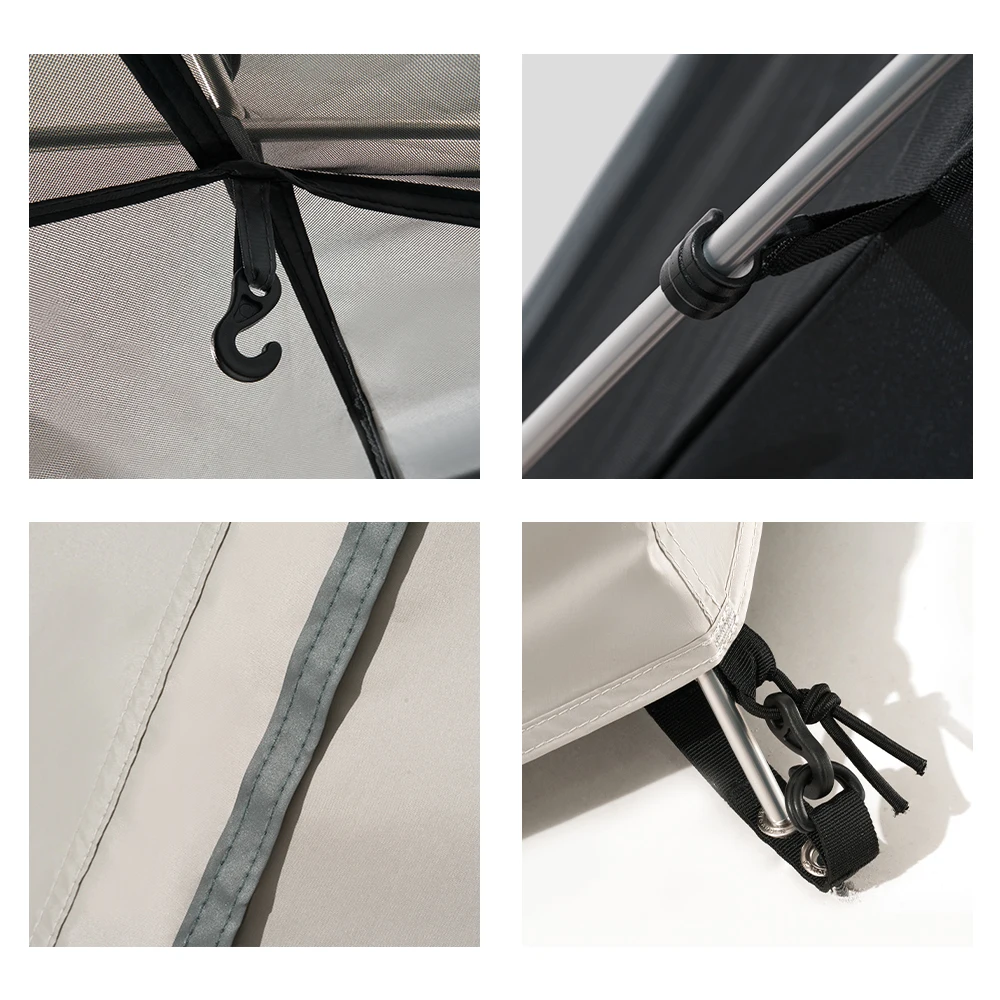
Easiest Setup: From Car to Camp in Minutes
The Coleman Sundome 2 exemplifies user-friendly design, making it the perfect choice for campers who prioritize convenience or those new to outdoor adventures. Its straightforward setup process takes the frustration out of camp preparation, getting you relaxing faster.
Key Specifications:
– Weight: 7 lbs 8 oz (3.4 kg)
– Floor dimensions: 82 x 58 inches (208 x 147 cm)
– Peak height: 48 inches (122 cm)
– Seasons: 2-3 season (moderate conditions)
– Doors: 1 door
– Packed size: 24 x 6 inches (61 x 15 cm)
The Sundome’s setup simplicity comes from its minimal, color-coded pole design and intuitive sleeve-and-clip system. Most first-time users can have this tent fully assembled in 10 minutes or less without ever consulting the instructions. The continuous pole sleeves guide the poles into the correct position, eliminating guesswork.
Coleman’s unique pin-and-ring system securely anchors the poles to the tent body while being remarkably easy to connect, even with cold hands or limited dexterity. The rainfly attachment is equally straightforward, using simple hooks and adjustable straps that virtually anyone can master on their first attempt.
The exceptional headroom (48 inches) also makes the interior setup process more comfortable than most competing tents. You can easily stand on your knees while arranging sleeping bags and gear, eliminating the hunched-over shuffling required in lower-profile options.
Where the Sundome compromises is in weight, packed size, and extreme weather capabilities. At over 7 pounds, it’s best suited for car camping rather than backpacking. The partial rainfly design prioritizes ventilation and ease of setup over maximum weather protection, making it ideal for fair-weather camping but less suitable for heavy precipitation.
For campers who value simplicity and affordability over technical performance, the Sundome delivers exceptional user-friendliness at a remarkably accessible price point. Check out our easy setup camping tent options for more convenient camping solutions.
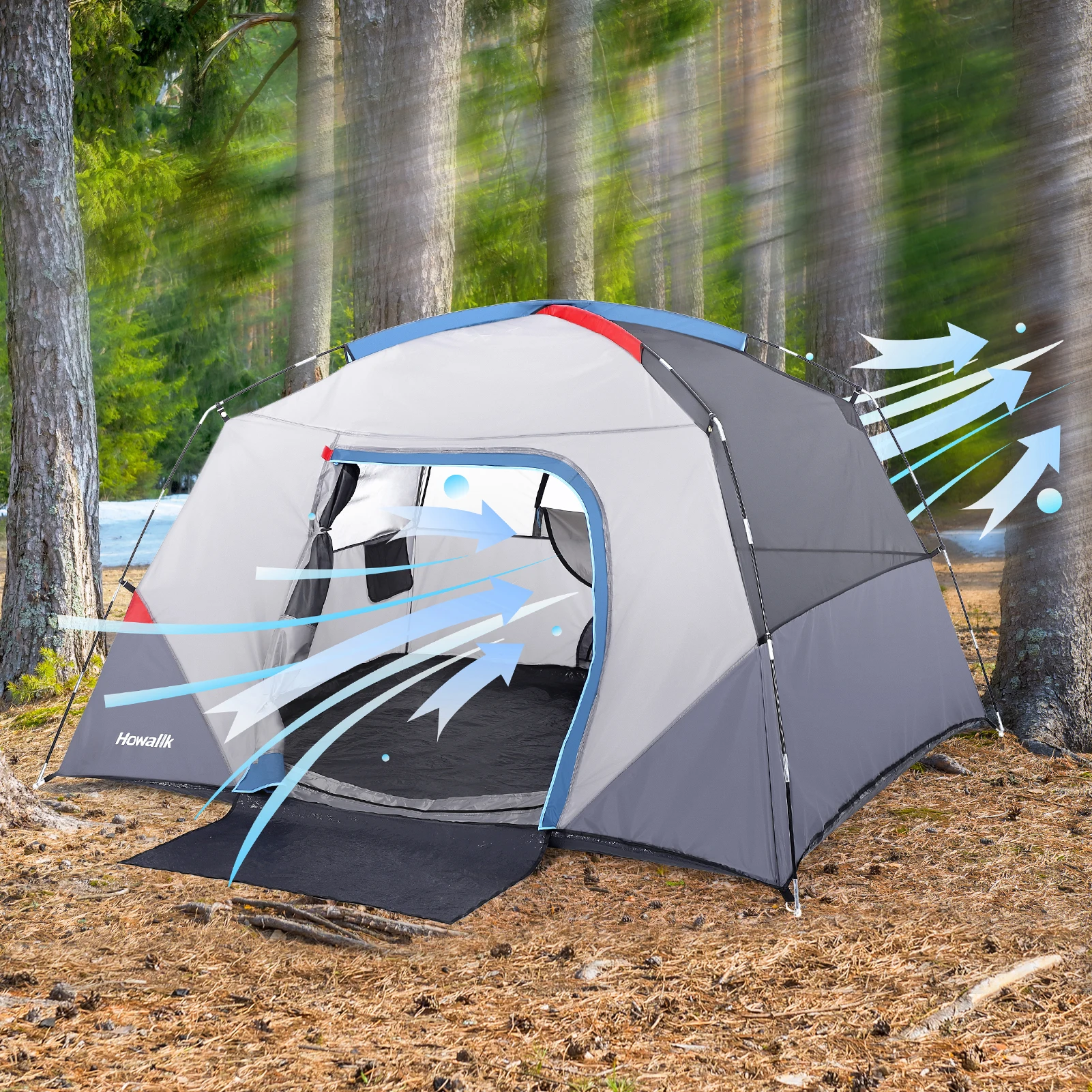
Understanding Dome Tent Capacity: The Truth About “Two-Person”
When manufacturers label a tent as “two-person,” they’re typically referring to the absolute minimum space needed for two standard sleeping pads placed directly side by side. This technical designation often doesn’t account for comfort or gear storage.
Standard sleeping pads measure approximately 20-25 inches wide (51-64 cm). When two are placed side-by-side, they require about 40-50 inches (102-127 cm) of tent width. Most two-person tents provide floor widths in this range—technically accommodating two sleepers, but with little to no additional space.
In practice, this means:
– Two average-sized adults can sleep in the tent
– Your shoulders may touch the tent walls
– Minimal or no space exists between sleeping pads
– Most gear must be stored in vestibules or outside
For many campers, especially those who are larger-framed or prefer more personal space, a “two-person” tent often feels restrictive. This is why many experienced campers follow the “size up” rule—selecting a three-person tent for comfortable two-person use.
Consider your specific needs:
– If you’re backpacking long distances, the weight savings of a true two-person tent may justify the snug fit
– For car camping where weight isn’t a concern, sizing up provides significant comfort benefits
– Couples who enjoy proximity may find true two-person tents perfectly adequate
– Those with dogs or who prefer personal space should definitely consider larger options
Our detailed dome tent capacity guide provides more information about realistic space expectations, while our guide to compact hiking shelters for two explores space-efficient options.
Essential Features and Specifications Explained
Understanding tent specifications helps you make informed choices based on your specific needs rather than marketing claims:
Weight Categories:
– Packed Weight: Everything included with the tent (poles, stakes, stuff sacks, etc.)—the actual weight you’ll carry
– Minimum Trail Weight: Just the tent body, rainfly, and poles—often used in marketing but rarely practical in real situations
– Fast-Pitch Weight: Rainfly, poles, and footprint (without tent body)—for minimalist setups in favorable conditions
Waterproof Ratings:
– Measured in millimeters of hydrostatic head (mm HH)
– 1,000mm: Minimum for light rain protection
– 1,500-3,000mm: Standard for 3-season tents
– 3,000mm+: Heavy-duty weather protection
– Floor ratings are typically higher than rainfly ratings
Fabric and Durability:
– Denier (D): Indicates fabric thickness—higher numbers mean more durable but heavier fabric
– 7-15D: Ultralight, requires careful handling
– 20-40D: Standard balance of weight and durability
– 50-70D+: Heavy-duty, excellent durability
Pole Materials:
– Aluminum: Lightweight and durable, standard in quality tents
– Carbon Fiber: Ultra-lightweight but expensive and less durable
– Fiberglass: Common in budget tents, heavier and more prone to breaking
– DAC Featherlite: Premium aluminum alloy offering optimal strength-to-weight ratio
Vestibule Design:
– Single vestibule: More affordable, adequate for solo users or minimalists
– Dual vestibules: Greater convenience for two users, each with their own storage and entry/exit
– Size matters: Look for at least 8-10 square feet per vestibule for adequate gear storage
Tents with well-designed vestibules offer significant practical advantages. Our camping tent vestibule collection features options with carefully considered storage spaces.
Weather Protection: Staying Dry and Secure
Effective weather protection in dome tents involves several integrated systems working together:
Rainfly Coverage:
– Full-coverage: Extends to or near the ground, providing maximum protection in sustained rain and wind
– Partial coverage: Protects roof and some sidewalls but prioritizes ventilation, suitable for fair weather
– Awning design: Some rainflies extend outward to create protected cooking or sitting areas
Floor Construction:
– Bathtub floor: Extends fabric up the tent walls (4-6 inches) to prevent water seepage during ground pooling
– Seam sealing: Critical for waterproofing where needle holes from stitching create potential entry points
– Higher denier fabric: Floors typically use thicker material than tent bodies to resist punctures and abrasion
Structural Stability:
– Guy out points: Additional attachment points for securing the tent in high winds
– Pole structure: More crossing points create greater stability
– Stake design: Quality stakes appropriate for your expected terrain (sand, rocky soil, etc.)
Condensation Management:
– Ventilation: Mesh panels, adjustable vents, and airflow design to minimize interior moisture buildup
– Double-wall construction: Creates insulating air barrier between tent body and rainfly
– Material breathability: Even waterproof fabrics have varying degrees of breathability
For backpackers facing uncertain weather, our waterproof backpacking tent collection offers reliable protection in a portable package.
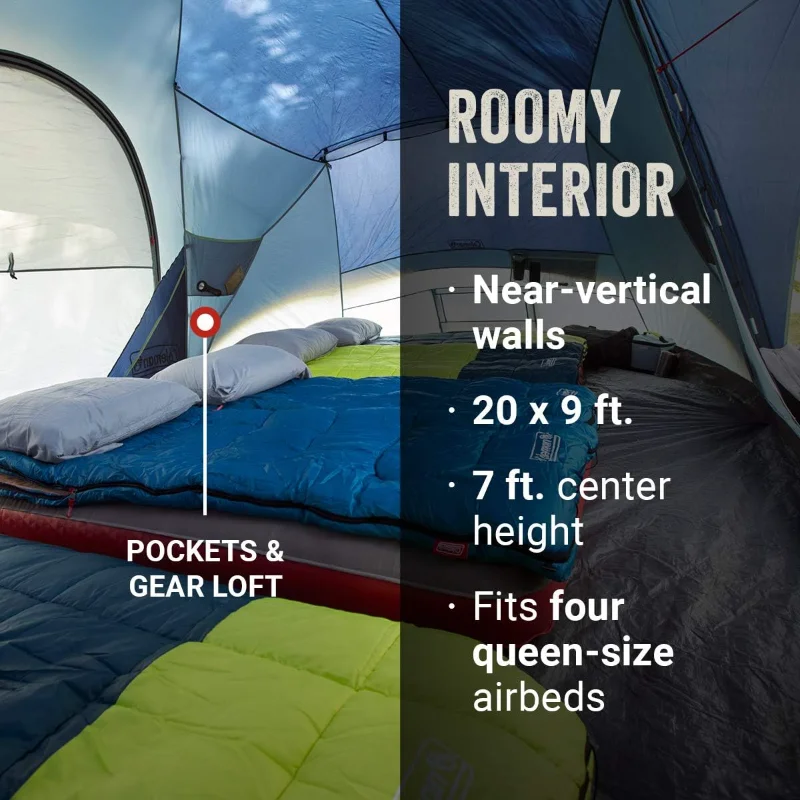
Livability Factors: Space, Comfort, and Convenience
The difference between a shelter and a comfortable home-away-from-home often comes down to thoughtful design elements that enhance livability:
Interior Volume:
– Peak height: Determines whether you can sit upright (36-48 inches typical for dome tents)
– Wall steepness: Near-vertical walls create more usable space than sharply sloped walls
– Floor dimensions: Length accommodates taller campers; width determines shoulder room
Door Design:
– Number of doors: Two doors eliminate the need to climb over your partner
– Door size: Larger doors make entry/exit easier, especially with gear
– Zip configuration: D-shaped or curved zippers provide wider openings than straight zippers
Storage Options:
– Interior pockets: Keep essentials organized and readily accessible
– Gear lofts: Overhead mesh platforms maximize floor space
– Vestibule area: External covered storage prevents muddy gear from entering sleeping space
Light and Visibility:
– Lighter-colored fabrics: Brighten the interior during daytime
– Reflective materials: Some tents incorporate reflective cords or trim for nighttime visibility
– Strategic mesh placement: Allows stargazing when conditions permit
Tents with superior ventilation offer enhanced comfort in warm conditions and better condensation management year-round. For comprehensive information about space efficiency and comfort, our ultimate guide to compact shelters for two campers provides detailed insights.
Lightweight Backpacking Tent, Ultralight Backpacking Tent, Ultralight Bivy Tent
Ultralight Single Person Camping Tent with Aluminum Poles for 3-Season Backpacking Waterproof DesignPrice range: $94.88 through $326.82 Select options This product has multiple variants. The options may be chosen on the product pageTall / Stand Up Camping Tent, Two Room Camping Tent
$407.93 Select options This product has multiple variants. The options may be chosen on the product pageLightweight Backpacking Tent, Ultralight Backpacking Tent, Waterproof Backpacking Tent
$391.05 Select options This product has multiple variants. The options may be chosen on the product pageHeavy Duty 4 Season Tent, Mountaineering Tent, Winter Camping Tent
$870.40 Select options This product has multiple variants. The options may be chosen on the product pageCompact Backpacking Tent, Lightweight Backpacking Tent, Waterproof Camping Tent
$335.52 Select options This product has multiple variants. The options may be chosen on the product pageUltralight Backpacking Tent, Ultralight Dome Tent, Winter Camping Tent
Price range: $369.63 through $370.07 Select options This product has multiple variants. The options may be chosen on the product page
Setting Up Your Dome Tent: Tips for Perfect Pitching
A smooth tent setup process ensures you start your camping experience positively, without frustration or wasted time:
Choose the right site:
– Look for level ground free of sharp objects and roots
– Avoid low spots where water could pool
– Consider sun/shade patterns throughout the day
– Position the tent entrance away from prevailing windPrepare the site:
– Remove sticks, stones, and debris
– Use a footprint or ground cloth to protect your tent floor
– Consider natural windbreaks like shrubs or rock formationsBasic dome tent setup sequence:
– Lay out the tent body flat on your chosen site
– Assemble and insert the poles through sleeves or attach to clips
– Secure the corners with stakes before raising the structure
– Attach the rainfly, ensuring proper orientation and even tension
– Stake out guy lines and adjust for proper tensionCommon setup mistakes:
– Forcing poles through sleeves (can tear fabric or break poles)
– Inadequate staking, allowing wind to catch and move the tent
– Uneven rainfly tension that creates flapping or water pooling
– Setting up directly under trees that drop sap or water
For those who prioritize convenience, pop-up dome tent options offer near-instant setup with minimal effort.
Durability and Materials: Investing in Longevity
Understanding tent materials helps you balance weight, durability, and cost effectively:
Tent Body Fabrics:
– Nylon: Lighter, more compressible, and faster drying than polyester, but more susceptible to UV damage
– Polyester: Better UV resistance and dimensional stability (less stretching when wet)
– Ripstop weave: Incorporates reinforcement threads to prevent tears from spreading
– DCF (Dyneema Composite Fabric): Ultra-lightweight and waterproof but extremely expensive
Rainfly Materials:
– Silicone-coated nylon (silnylon): Excellent waterproofing with minimal weight penalty
– Polyurethane (PU) coated: Standard waterproofing treatment, less expensive but heavier
– Silicon on both sides vs. PU/silicon hybrid: Double-sided silicone offers better durability but can’t be seam-taped
Pole Materials:
– Aluminum alloys: DAC poles use proprietary aluminum alloys that optimize strength-to-weight ratio
– Carbon fiber: 30-40% lighter than aluminum but more brittle and significantly more expensive
– Fiberglass: Most affordable but heavier and more prone to breakage, especially in cold conditions
High-Stress Areas:
– Quality tents reinforce corners, stake points, and pole insertion points
– Bar-tacking (dense stitching) at connection points distributes force
– Pole hubs and connectors should be made from durable composite materials
For couples seeking the ideal balance of durability and weight, our compact dome tents for couples guide offers recommendations based on actual field testing.
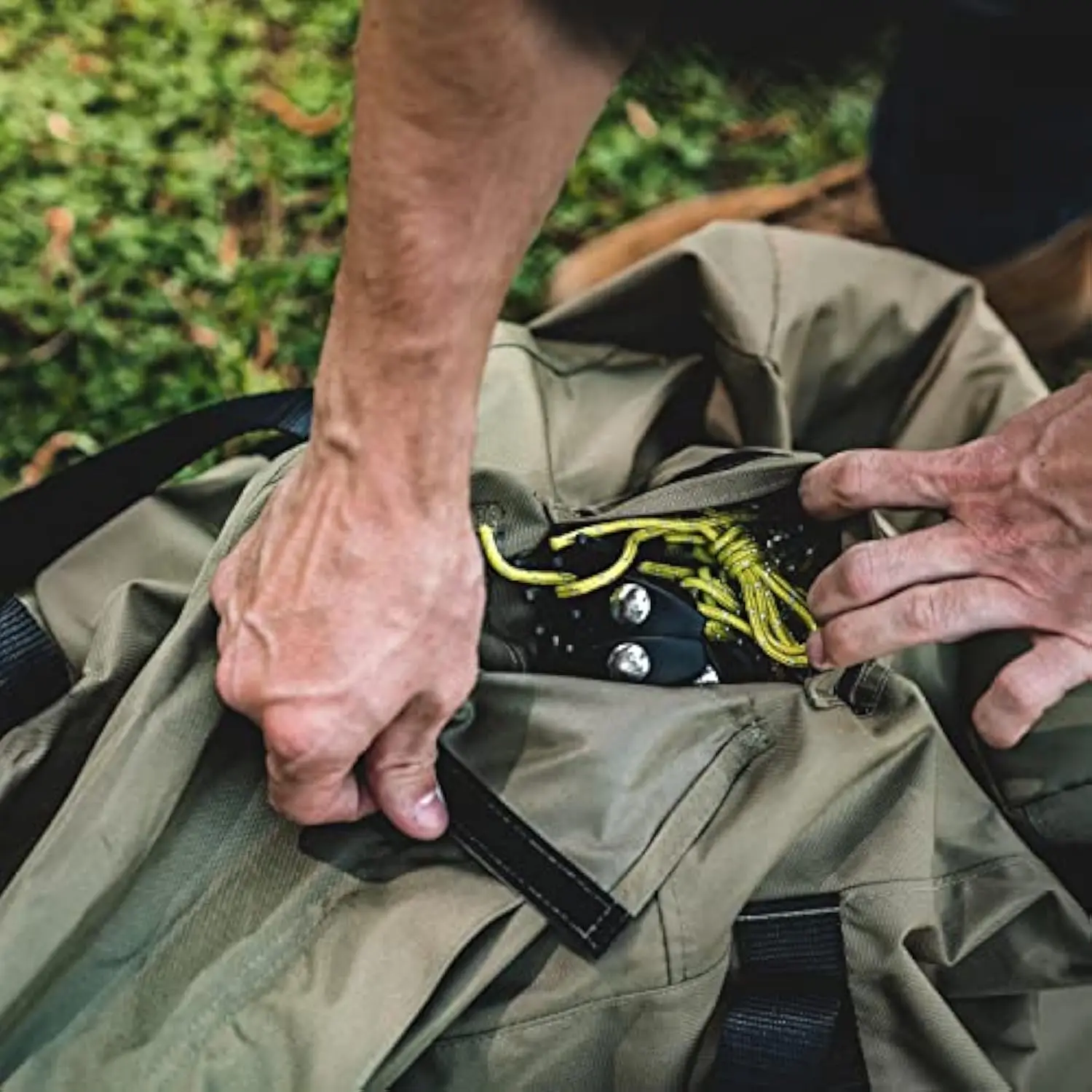
Seasonal Considerations: When to Use Your Dome Tent
Tent seasonality ratings help you match your shelter to expected weather conditions:
3-Season Tents (Spring, Summer, Fall):
– Designed for temperatures above freezing
– Focus on ventilation and condensation management
– Typically feature significant mesh panels for airflow
– Can handle light snow but not snow loading
– Standard choice for most recreational campers
Extended 3-Season (3+ Season):
– More robust than standard 3-season designs
– Less mesh and more fabric panels for better heat retention
– Stronger pole structures for moderate snow and wind
– Ideal for early spring and late fall trips
4-Season (All-Season/Winter):
– Engineered for harsh winter conditions
– Minimal mesh to retain heat
– Robust pole structure to withstand snow loading
– Often feature lower profiles to reduce wind exposure
– Generally heavier and less ventilated than 3-season options
When planning trips during transitional seasons or in areas with unpredictable weather, consider whether your standard 3-season tent provides adequate protection. For winter camping adventures, our 4-season winter 2-person tent collection offers specialized options designed for extreme conditions.
For year-round adventurers, understanding the principles behind durable tents for all seasons helps in selecting versatile equipment that performs across varying conditions.
How to Choose Based on Your Camping Style
Your typical camping scenario should heavily influence your tent selection:
Weekend Car Camping:
– Weight and packed size are less important
– Prioritize interior space, comfort, and setup ease
– Look for features like higher ceilings and extra storage
– Consider more durable (and heavier) materials
– Budget options can work well here
Multi-Day Backpacking:
– Weight becomes a primary concern
– Balance minimalism with necessary comfort
– Higher-quality materials justify the extra cost
– Consider how weight distributes between partners
– Features like dual doors become more valuable
Solo Use of 2-Person Tent:
– Extra space for gear storage inside the tent
– More comfortable sleeping diagonal arrangement
– Worth the weight penalty for improved comfort
– Consider asymmetrical designs that maximize space
Fair Weather vs. All-Season Adventures:
– Occasional fair-weather campers can opt for simpler designs
– Frequent campers in variable conditions need versatile protection
– Consider your tolerance for risk versus pack weight
For ultralight backpacking adventures, our ultralight dome tent collection offers specialized options that minimize weight without sacrificing essential protection.
Budget Considerations: What You Get at Different Price Points
Tent pricing generally correlates with materials, features, and long-term performance:
Budget ($100-200):
– Heavier materials (fiberglass poles, thicker polyester)
– Simpler designs with fewer features
– Often single-door configurations
– Adequate for occasional use in favorable conditions
– Examples: Coleman Sundome, Alps Mountaineering Meramac
Mid-Range ($200-400):
– Aluminum poles replace fiberglass
– Better waterproofing and seam construction
– Improved ventilation systems
– Often includes two doors and vestibules
– Good balance of quality and value
– Examples: REI Passage 2, Marmot Tungsten 2P
Premium ($400+):
– Ultralight materials without sacrificing durability
– Sophisticated pole architectures for space-to-weight efficiency
– Superior weather protection and ventilation
– Refined details like smooth-operating zippers and strategic reinforcements
– Examples: Big Agnes Copper Spur, MSR Hubba Hubba, Nemo Dagger
Consider your frequency of use when determining your budget. For occasional campers (2-3 weekends per year), budget options often suffice. For regular adventurers, premium tents typically offer better value over time through enhanced durability and performance.
For those seeking quality options across different price ranges, our 2-person backpacking tents collection offers carefully selected choices at various price points.
Dome vs. Other Tent Designs: Why Choose a Dome?
Dome tents have distinct advantages compared to other popular tent designs:
Dome vs. Tunnel Tents:
– Dome advantages: Freestanding for easier setup and site flexibility; better headroom in center
– Tunnel advantages: More efficient floor-to-weight ratio; potentially more storm-worthy when properly oriented
Dome vs. Cabin Tents:
– Dome advantages: Much better wind performance; lighter weight; simpler setup
– Cabin advantages: Nearly vertical walls maximize interior space; better for family camping
Dome vs. Pyramid/Tarp Tents:
– Dome advantages: Easier setup for beginners; bug protection included; freestanding
– Pyramid advantages: Ultralight when using trekking poles; excellent weather protection for weight
The dome design excels in offering a balanced combination of:
– Wind stability through its curved structure
– Setup simplicity with intuitive pole configurations
– Interior space efficiency with reasonable headroom
– Versatility across different environments
For most recreational campers, especially those camping as pairs, dome tents provide an ideal combination of practical features without requiring advanced setup skills or specialized equipment.
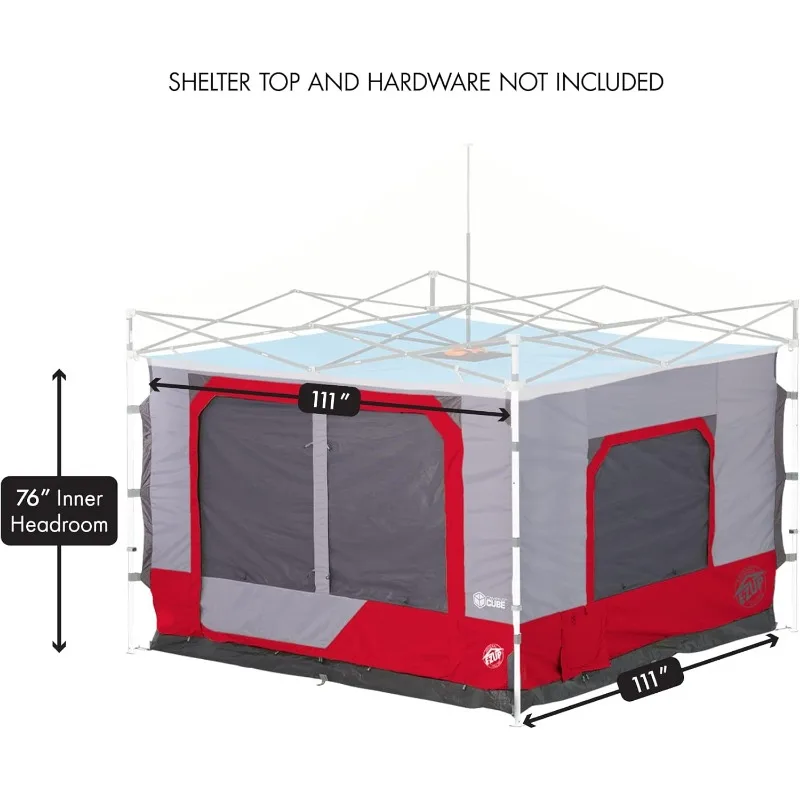
Accessories and Add-ons Worth Considering
The right accessories can significantly enhance your tent experience:
Footprints:
– Custom-fitted groundsheets that protect your tent floor
– Enable fast-pitch setup options (rainfly + footprint + poles)
– Extend tent life by preventing abrasion and punctures
– Custom footprints ensure proper size without water-catching edges
Guy Lines:
– Reflective replacements improve nighttime visibility
– Aftermarket lines often offer better tensioning systems
– Additional guy lines can strengthen existing attachment points
– Essential for maximizing stability in adverse conditions
Stakes:
– Lightweight aluminum Y-stakes offer excellent holding power for most conditions
– Snow stakes provide anchoring in snow or loose sand
– Titanium shepherd’s hooks minimize weight for backpacking
– Always bring extra stakes—they’re easy to lose and critical for proper setup
Repair Kits:
– Field-repair tape for temporary fabric patches
– Pole repair sleeves to splint broken poles
– Seam sealer for refreshing waterproofing
– Spare cord for makeshift guy lines or pole repairs
For quick-setup options that still offer excellent protection, our waterproof pop-up tent collection provides convenient solutions without sacrificing weather resistance.
Care and Maintenance: Extending Tent Life
Proper tent care dramatically extends your investment’s lifespan:
Cleaning and Storage:
– Never store a tent damp or dirty—mildew can permanently damage fabrics
– Clean with mild soap and water only—never use detergents or washing machines
– Thoroughly air dry before storage in a loose, breathable bag
– Store in a cool, dry place away from direct sunlight
UV Protection:
– Limit unnecessary sun exposure—UV damages tent fabrics over time
– Consider a separate sun tarp for extended base camping
– Apply UV-protective sprays to extend fabric life
– Take down tents during the day if not needed for shade
Zipper Care:
– Keep zippers clean of sand and dirt
– Never force stuck zippers—back up and clear the obstruction
– Apply zipper lubricant periodically to maintain smooth operation
– Always use two hands when zipping to reduce stress on the track
Field Repairs:
– Secure small tears immediately with repair tape to prevent spreading
– Learn to splice broken poles with repair sleeves
– Carry small repair kit on every trip
– Address problems immediately rather than allowing them to worsen
Frequently Asked Questions About 2-Person Dome Tents
Are footprints necessary for dome tents?
While not strictly necessary, footprints significantly extend your tent’s lifespan by protecting the floor from abrasion, punctures, and ground moisture. For expensive tents especially, the footprint’s cost is justified by the protection it provides. Custom-fitted footprints are best, as oversized generic groundsheets can collect water beneath the tent.
How much interior space do two people really need?
For comfortable two-person use, look for at least 30-32 square feet of floor space. Width is particularly important—50-52 inches accommodates two standard sleeping pads with minimal overlap. If you’re larger-framed or dislike touching shoulders while sleeping, consider a three-person tent for two-person use.
Can one person easily set up a dome tent?
Most modern two-person dome tents are designed for single-person setup. Freestanding designs are particularly easy for solo setup, as they don’t require immediate staking. Even in windy conditions, most experienced users can erect a two-person dome tent alone in under 10 minutes.
What’s the difference between freestanding and semi-freestanding tents?
Freestanding tents maintain their structure without stakes, allowing you to pick up and move the pitched tent to find the optimal location. Semi-freestanding tents require some staking to achieve their full shape and stability. Fully freestanding designs offer greater site flexibility but often weigh slightly more than semi-freestanding alternatives.
How important are vestibules for a 2-person tent?
Vestibules are extremely valuable for two-person tents, providing crucial storage space for boots, packs, and other gear that would otherwise occupy limited interior space. Dual vestibules allow each camper their own storage area and entry/exit point, significantly enhancing convenience and comfort, especially during rainy conditions.
What’s the most important feature for storm protection?
Full-coverage rainflies that extend to the ground provide the best protection in sustained storms. While waterproof ratings matter, complete coverage prevents wind-driven rain from reaching the tent body. Secondary considerations include a strong pole structure with multiple crossing points and adequate guy-out options to maintain stability in high winds.
Side-by-Side Comparison: Top 5 Two-Person Dome Tents
| Feature | MSR Hubba Hubba NX 2 | REI Co-op Passage 2 | Big Agnes Copper Spur HV UL2 | North Face Mountain 25 | Coleman Sundome 2 |
|---|---|---|---|---|---|
| Price | $$$$ | $$ | $$$$ | $$$$$ | $ |
| Packed Weight | 3 lbs 14 oz (1.76 kg) | 5 lbs 10 oz (2.55 kg) | 3 lbs 2 oz (1.42 kg) | 9 lbs 15 oz (4.51 kg) | 7 lbs 8 oz (3.4 kg) |
| Floor Area | 29 sq ft (2.7 sq m) | 31 sq ft (2.9 sq m) | 29 sq ft (2.7 sq m) | 32 sq ft (3.0 sq m) | 35 sq ft (3.3 sq m) |
| Peak Height | 40 in (102 cm) | 40 in (102 cm) | 40 in (102 cm) | 41 in (104 cm) | 48 in (122 cm) |
| Doors/Vestibules | 2/2 | 2/2 | 2/2 | 2/1 | 1/0 |
| Season Rating | 3-season | 3-season | 3-season | 4-season | 2-3 season |
| Standout Feature | Perfect balance of features | Excellent value | Ultralight with good space | Extreme weather protection | Simple setup & affordability |
| Best For | All-around use | Budget-conscious campers | Backpackers | Extreme conditions | Casual campers |
This comparison highlights the trade-offs between different tent designs, helping you prioritize features that match your specific camping needs and preferences.

